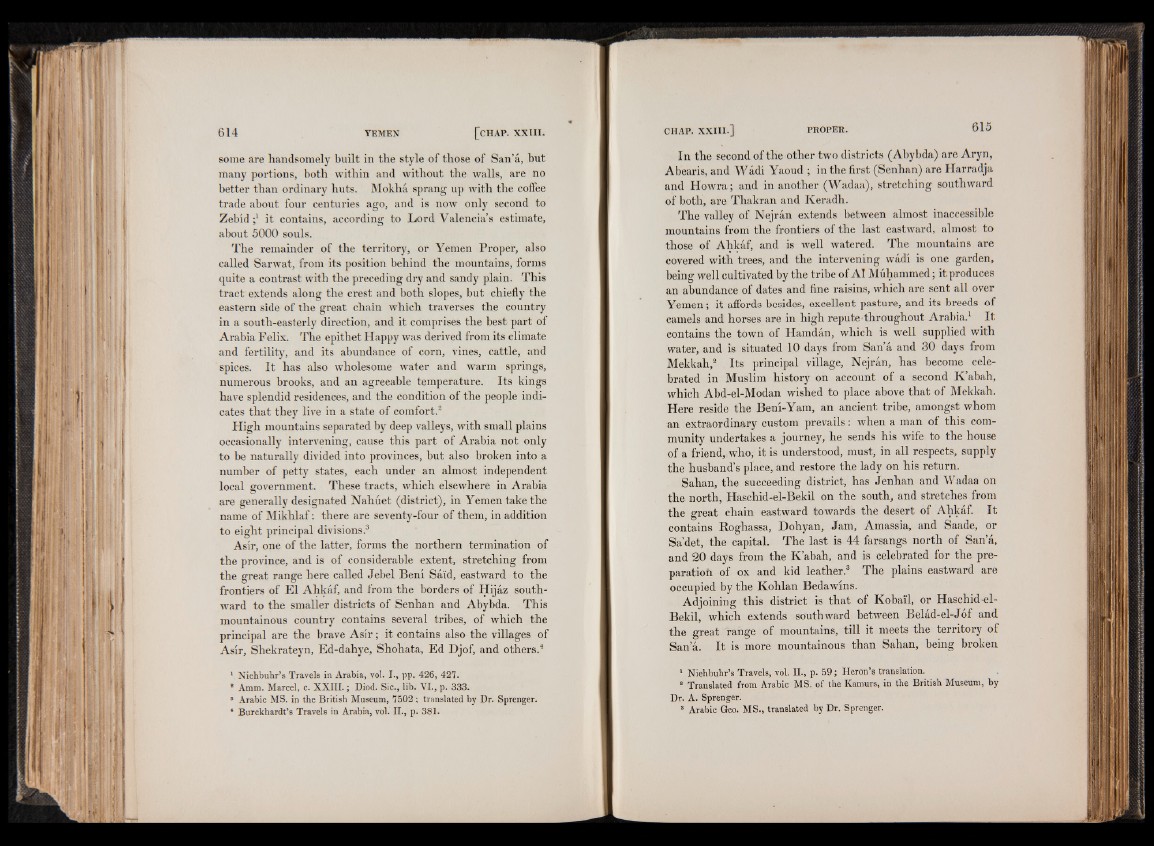
some are handsomely built in the style of those of San’a, but
many portions, both within and without the walls, are no
better than ordinary huts. Mokha sprang up with the coffee
trade about four centuries ago, and is now only second to
Zebid it contains, according to Lord Valencia’s estimate,
about 5000 souls.
The remainder of the territory, or Yemen Proper, also
called Sarwat, from its position behind the mountains, forms
quite a contrast with the preceding dry and sandy plain. This
tract extends along the crest and both slopes, but chiefly the
eastern side of the great chain which traverses the country
in a south-easterly direction, and it comprises the best part of
Arabia Felix. The epithet Happy was derived from its climate
and fertility, and its abundance of corn, vines, cattle, and
spices. It has also wholesome water and warm springs,
numerous brooks, and an agreeable temperature. Its kings
have splendid residences, and the condition of the people indicates
that they live in a state of comfort.2
High mountains separated by deep valleys, with small plains
occasionally intervening, cause this part of Arabia not only
to be naturally divided into provinces, but also broken into a
number of petty states, each under an almost independent
local government. These tracts, which elsewhere in Arabia
are generally designated Nahuet (district), in Yemen take the
name of Mikhlaf: there are seventy-four of them, in addition
to eight principal divisions.3
Asir, one of the latter, forms the northern termination of
the province, and is of considerable extent, stretching from
the great range here called Jebel Beni Said, eastward to the
frontiers of El Ahkaf, and from the borders of Hijaz southward
to the smaller districts of Senhan and Abybda. This
mountainous country contains several tribes, of which the
principal are the brave Asir; it contains also the villages of
Asir, Shekrateyn, Ed-dahye, Shohata, Ed Djof, and others.4
1 Niehbuhr’s Travels in Arabia, vol. I., pp. 426, 427.
8 Amm. Marcel, c. X X III.; Diod. Sic., lib. VI., p. 333.
3 Arabic MS. in the British Museum, 7502 ; translated by Dr. Sprenger.
1 Burckhardt’s Travels in Arabia, vol. II., p. 381.
In the second of the other two districts (Abybda) are Aryn,
Abearis, and Wadi Yaoud ; in the first (Senhan) are Harradja
and Howra; and in another (Wadaa), stretching southward
of both, are Thakran and Keradh.
The valley of Nejran extends between almost inaccessible
mountains from the frontiers of the last eastward, almost to
those of Ahkaf, and is well watered. The mountains are
covered with trees, and the intervening wadi is one garden,
being well cultivated by the tribe of AI Muhammed; it produces
an abundance of dates and fine raisins, which are sent all over
Yemen; it affords besides, excellent pasture, and its breeds of
camels and horses are in high repute throughout Arabia.1 It
contains the town of Hamdan, which is well supplied with
water, and is situated 10 days from Sana and 30 days from
Mekkah,2 Its principal village, Nejran, has become celebrated
in Muslim history on account of a second K’abah,
which Abd-el-Modan wished to place above that of Mekkah.
Here reside the Beni-Yam, an ancient tribe, amongst whom
an extraordinary custom prevails: when a man of this community
undertakes a journey, he sends his wife to the house
of a friend, who, it is understood, must, in all respects, supply
the husband’s place, and restore the lady on his return.
Sahan, the succeeding district, has Jenhan and Wadaa on
the north, Haschid-el-Bekil on the south, and stretches from
the great chain eastward towards the desert of Ahkaf. It
contains Roghassa, Dohyan, Jam, Amassia, and Saade, or
Sa’det, the capital. The last is 44 farsangs north of Sana,
and 20 days from the K’abah, and is celebrated for the preparation
of ox and kid leather.3 The plains eastward are
occupied by the Kohlan Bedawlns.
Adjoining this district is that of Kobai'l, or Haschid-el-
Bekil, which extends southward between Belad-el-Jof and
the great range of mountains, till it meets the territory of
San’a. It is more mountainous than Sahan, being broken
* Niehbuhr’s Travels, vol. II., p. 59; Heron’s translation.
8 Translated from Arabic MS. of the Kamurs, in the British Museum, by
Dr. A. Sprenger.
3 Arabic Geo. MS., translated by Dr. Sprenger.